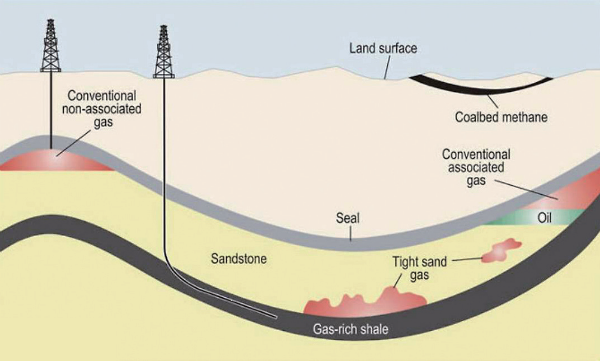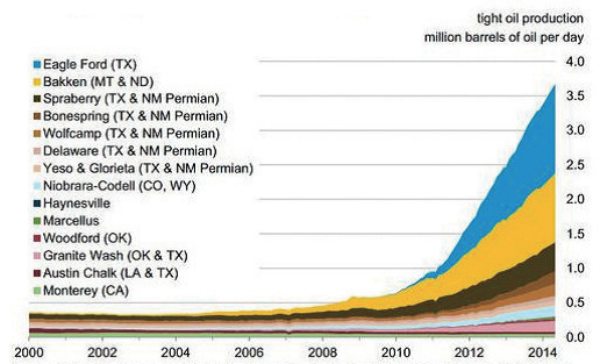Throughout history, energy security, the uninterrupted ability of energy sources at an affordable price, has always been a serious problem while managing a country. In particular, Korea, being a country with a shortage of natural resources, is importing more than 90% of the energy that we use. Consequently, only a slight change in the oil price can have a tremendous effect on peoples’ everyday lives. In this situation, shale energy, a substitute for the traditional energy source, is drawing attention worldwide, opening up a renaissance of the enrgy resource once again. The Sungkyun Times (SKT) now explores the concept of this newly rising energy and how it is going to affect the global and Korean energy market.
Brief Introduction of the Shale Energy
Shale energy is defined as the natural energy that is found trapped within shale formations. It can exist both in liquid and gas form. They are referred to as shale oil and shale gas respectively and they are usually found about two to four meters underground.

Generally, when traditional energy is created in a layer of rock, it migrates towards the ground’s surface and comes together producing a kind of underground reservoir. Therefore, a traditional pipeline to extract energy had a vertical shape. On the other hand, shale energy has a slightly different characteristic.
Low permeability, which indicates the ability of a material, such as rock, to transmit fluids, is one of the distinctive features of shale. This makes it difficult for energy sources in shale to travel across the layers of rock. Shale energy is tightly locked in a layer of shale, being spread broadly on a stratum. Therefore, a pipeline used in shale energy production is more sophisticated, made in an L shape. In summary, the concept of shale energy is highly related to ‘where it is found’, because the chemical composition of the shale energy is almost the same as that of traditional energy.
Shale energy was first discovered in the 1800s, but it was not until 1998 that this energy was extracted commercially. By then, hydraulic fracking, a brand-new technique of drilling which was invented by Georgy Phydias Mitchell, made it possible for shale energy to become popular. Hydraulic fracking is a method in which a mixture of water, sand and chemicals is injected into a pipe at a high pressure. This pressure creates fractures in the rock. Then the pressure is lowered quickly, making the energy inside the shale swell up along the pipe from the cracks of the rocks. Shale energy is one of the unconventional resources in that it is mined by a new drilling technology.
Expectations and Controversies over Shale Energy
Strengths of Shale Energy
- Abundant Amounts of the Deposits
According to the United States Energy Information Administration (EIA), the reserve of shale gas may reach to about 206 trillion ㎥. The total amount of shale energy is enough for the whole world to use it for 60 years from now, which is one and a half times longer than that of conventional oil. Some experts even argue that this is nothing more than a prediction, and this figure could increase as time passes.

- Omnipresence of the Energy Source
Unlike traditional oil, of which reserves are concentrated mainly in the Middle East, shale energy is diversely spread throughout the world. If shale energy becomes well developed, it would be possible for many countries to become independent in energy consumption. Since Korea is one of the five major oil importing countries, it is a good thing that the suppliers of shale energy could become more diversified. Through competition, shale energy inhibits the price of oil to skyrocket. While Organization of Petroleum Exporting Countries (OPEC) countries agreed to cut the production of the oil in September, its impact on oil price was insignificant. From this January, the total output of oil is decreasing on average by 106 barrels every day. The range of the fluctuation in the price of oil, however, was no bigger than $4, since American shale energy has substituted traditional oil. It shows that the American shale energy has played a significant role in stabilizing the oil price.
Remaining Concerns
- Adverse Effect on the Environment
Since fracking uses L-shaped pipelines which are widely spread, it could cause massive environmental destruction when extracted liquid spills out from the pipes. In particular, underground water is first to be polluted. Among the mixtures which are used in fracking methods, there are some harmful chemicals such as heavy metals and surfactant which can be fatal to humans. Some countries are doubtful about the safety of fracking, concerned about its negative influence to drinking water. Germany, for example, has been prohibiting the production of shale energy since last June, only allowing test drilling under the state government’s permission.
- Possibility of an Artificial Earthquake
While extracting shale energy, many rocks are shattered and a large amount of water is injected underground which will inevitably weaken the solidity of the ground. Some scientists are concerned that weakened ground could lead to more frequent earthquakes. Numerous research shows there is a correlation between the production of shale energy and artificial earthquakes. For example, a study by the geophysics research team at Cornell University found that the state of Ohio has experienced earthquakes more than 30 times after it became a big supplier of shale energy. Shale energy companies, however, insist that there is not enough scientific evidence that drilling triggers more earthquakes. Even if it does, they say that problems can be solved by the development of techniques which use alternative methods such as electric shocks instead of water injection.


Current States of the Shale Energy
The shale energy industry has been constantly growing since the 2000s. The total output of shale energy in the United States (US) has rapidly increased during the past five years, by seven to eight times. Not only the US, which takes the second place in the amount of the estimated shale energy resources, but also many countries around the world are showing an active movement to develop shale energy. Considering that only the US and Canada now possess the techniques to produce shale energy for now, this will boost the output of shale energy even more. China, which is known to have the highest reserves in the world, also entered the shale energy market last October. There are several factors for the recent boom in shale energy.
Internal Reasons
The biggest factor which has prevented shale energy from being popularized is that it was not economical. In the past, when the low oil price trend continued, many shale oil companies ended up becoming bankrupt and some people even called this phenomenon the ‘Shale Bubble’. Nonetheless, the shale energy industry managed to survive thanks to the constant development of production techniques. In the early 2000s, when the shale energy industry was at an early stage, the unit cost of production was about $80 to $90 per barrel, whereas the cost has now dropped by about $50.
External Reason
This boom in shale energy is closely related to the recent American president election. Donald Trump, as new president of the US, suggested an ‘American Energy First Plan’ shortly after his inauguration. It showed Trump’s strong will that the US should stop depending on foreign oil and utilize every possible energy source in the US itself, which is yet to be exploited. Shale energy is a good example. This shows Trump's energy policy is completely opposite from that of the Obama administration, which strived to promote the development of renewable energy. Trump is known to be a typical climate change skeptic and often criticized that the American energy industry has been suppressed because of the excessive regulation of the former government. On January 1st, he also gave an administrative order resuming construction of the Dakota Access Pipeline which was blocked by Obama’s administration because of the possibility of it harming the environment. The Dakota Access Pipeline is a 1,886km long underground shale oil pipeline connecting North Dakota to Illinois. When this project is complete, up to 57 million barrels of shale oil can be transported across the nation in a day.
Nevertheless, Trump’s attempts to develop US energy sources implies more than a desire for the stable supply of energy or financial gains. This plan has the political purpose in America to try and keep OPEC in check. OPEC countries have fallen into a dilemma, regarding the total oil output. If they decreased the output, there would be a rise in the price of oil which is a serious threat to their traditional oil industry. Since shale energy has a high production cost, the shale industry would naturally become a dying industry after losing its competence over traditional oil. On the other hand, OPEC countries can increase the output and make the price of oil drop, which would become a serious financial loss to OPEC countries. Nonetheless, it will not be easy for OPEC to keep up this production cut forever. Trump is also taking a firm line by encouraging shale companies to endure the low-cost of the oil by giving heavy subsidies. Abdalla Salem El-Badri, OPEC secretary general, also expressed his concern, stating that “Shale oil in the United States? I don’t know how we are going to live together.” Considering that energy sources have always been used for political means, the power struggle between the US and OPEC countries is expected to last for a while.
Shale Energy in Korea
Current State of Korea
Unfortunately, shale energy has not been found in Korea yet. Therefore, it is obvious that Korea should still rely on many foreign energy producers. In particular, under Trump’s protectionism, which indicates the doctrine that domestic industries should be protected from foreign competition by the imposition of duties, quotas, etc., on foreign goods, which means that it would be more likely for the US to put pressure on Korea to import more shale energy. Consequently, shale energy will actively broaden its market share in Korea. More and more enterprises, both private and public, are starting to introduce shale energy in their businesses. For instance, SK E&S has started operating a gas-fueled power plant from February 2nd in Paju, Korea. Being the first power plant run by shale-gas in Korea, it has the capacity for generating 1800 megawatts per hour. Korea Gas Corporation (KOGAS) has also decided to bring in shale gas from this June. About 2.8million tons of shale gas will be imported every year which is 9% of the total natural gas consumed in Korea each year.
Impacts of Shale Energy to Korean Society
From Korea’s point of view, growing imports of shale energy are generally a favorable factor. Since the price of oil is directly linked to the consumer price, the additional energy source will contribute to the stabilization of the consumer price. Nevertheless, there is also a possibility for some major Korean industries that they will face hardship. For instance, the shipbuilding industry could also be in trouble since manufacturing drill-ships, which are used to extract traditional oil, have been one of the main sources of its income until now. Korea, however, can turn this crisis into a new opportunity. A possible strategy is Korea working as a middleman while the US export the shale energy to other Northeast Asian countries. Korea is considered to have the ideal environment to process the raw shale energy and resell it than any of the other Northeast Asian countries because of its location and sustainable weather conditions. Therefore, developing a leading processing technique for shale energy will be more crucial than anything else.
Shale energy is now redrawing the global energy map. Along with the advance of this new type of energy, Korea should contemplate its way to wisely cope with the change in the energy industry. Hopefully, this change will work as a good opportunity to solve the unstable supply of energy in Korea.
